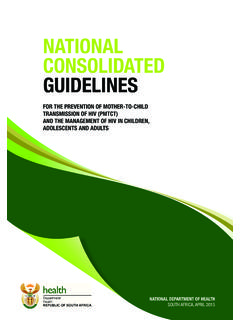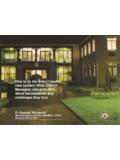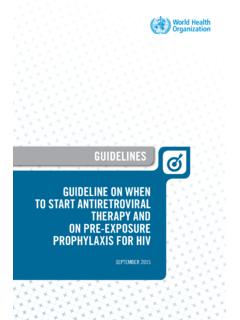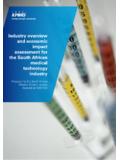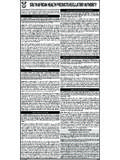Transcription of HIV and/or AIDS awareness among adolescents in a South ...
1 AccessSouthern african Journal of HIV Medicine ISSN: (Online) 2078-6751, (Print) 1608-9693 Page 1 of 7 Original ResearchRead online:Scan this QR code with your smart phone or mobile device to read :Simon Taukeni1 Ronel Ferreira2 Affiliations:1 HIV and AIDS Unit, University of Fort Hare, South Africa2 Department of Educational Psychology, University of Pretoria, South AfricaCorresponding author:Simon Taukeni, 16 Sept. 2015 Accepted: 22 Mar. 2016 Published: 09 June 2016 How to cite this article:Taukeni S, Ferreira R. HIV and/or AIDS awareness among adolescents in a South african at-risk rural community.
2 S Afr J HIV Med. 2016;17(1), a418. : 2016. The Authors. Licensee: AOSIS. This work is licensed under the Creative Commons Attribution estimates that about 35 million people were living with HIV and/or AIDS in 2013, of which were situated in sub-Saharan Africa. In South Africa alone, million children had been orphaned by AIDS at the time and around million people were living with HIV and/or Worldwide, many of those affected are women and narrowing the focus to adolescent children and young adults, worldwide figures indicated million HIV-positive youth within the age range 15 In many parts of the globe, young people, particularly adolescents .
3 Are at great risk of contracting the virus through sexual activity as well as sexual exploitation and Durojaiye5 as well as UNAIDS6 indicate that, worldwide, 45% of people contracting HIV and/or AIDS are youth aged 15 24 years. This is supported by Ebeniro7 and other scholars who found that adolescents aged 15 24 years constitute the largest population of HIV-infected subjects. Similarly, AVERT2 indicates a high HIV prevalence in the age group 15 : The devastating effects of HIV and/or AIDS are widely documented. Despite ongoing efforts to address the challenges associated with the pandemic, the impact on children orphaned because of the disease, as well as on adolescents , remains problematic.
4 More specifically, orphaned adolescents living in poverty are particularly vulnerable and are often exposed to, for example, emotional and physical abuse and transactional sexual exploitation. Against this background, the importance of informed awareness among adolescents is continually emphasised, yet the outcomes of awareness campaigns require ongoing : The main objective of this study was to explore HIV and/or AIDS awareness among adolescents living in a rural community in South Africa, in the Chris Hani District of the Eastern Cape Province.
5 Sixteen adolescents (aged 12 24) who had lost one or both of their parents because of HIV and/or AIDS-related reasons were purposefully selected to participate in the : For this qualitative investigation, we implemented a descriptive case study design. Semi-structured individual interviews, observation and field notes were used to collect and document data, and inductive thematic analysis was completed using the software programme : The three themes that were identified relate to HIV and/or AIDS awareness , disclosure of parents HIV and/or AIDS status and experiences of adolescents surrounding the death of their parents.
6 adolescents of the community viewed HIV and/or AIDS as an infectious disease that can lead to death; however, this can be prevented by avoiding at-risk sexual behaviour. Schools and family members were the main sources of information regarding HIV and/or AIDS to the participants. Even though parents tended not to disclose their HIV and/or AIDS status, adolescents became aware of their parents status when reading about this on their parents medical report cards or when being told about the status by others following the death of their parents.
7 For adolescents , their parents deaths were associated with the parents being chronically ill or showing visible signs of deterioration such as weight : The study concludes that even though current campaigns and informative interventions have seemingly succeeded in ensuring HIV and/or AIDS awareness among adolescents also those in remote areas continued educational campaigns are important. Such initiatives may prove to be beneficial by focusing on ways that parents can discuss HIV and/or AIDS-related issues with their children and disclose an HIV-positive and/or AIDS awareness among adolescents in a South african at-risk rural communityRead online:Scan this QR code with your smart phone or mobile device to read 2 of 7 Original AccessAdolescents find themselves in a developmental phase where they search for an identity and are often negatively influenced by their peers.
8 Adding poverty and parental sickness, or orphanhood, to the challenges already experienced during adolescence will result in high levels of vulnerability. More specifically, orphaned adolescents living in poverty are particularly at risk of emotional and physical abuse and transactional sexual african context as backdrop to the studyAccording to Statistics South Africa,9 this country accounts for the highest number of people living with HIV and/or AIDS in the world, currently estimated at of the total population.
9 Sinelela et confirm this by very recently stating that: South Africa is home to the largest concentration of people living with HIV anywhere in the world; of all the HIV-positive people in the world, nearly one fifth live in South Africa. ( )In terms of the rise in numbers, it is rather concerning to note the increase from million people living with HIV and/or AIDS in South Africa in 2002 to million in HIV and/or AIDS pandemic has caused unprecedented suffering and social disruption for children and communities throughout sub-Saharan Even though all children are vulnerable and at risk of contracting HIV, it was, for example, reported in a study by Mpanju-Shumbusho12 that, in sub-Saharan Africa.
10 Teenage girls HIV infection rate is five times higher than the rate of infection among teenage boys. Against the background of the challenge of HIV and/or AIDS encountered by adolescents , it seems vitally important that their awareness of the risks associated with sexual behaviour, and the importance of applying this knowledge to real-life experience, is made (ages 10 19) find themselves in a phase of physical growth and development accompanied by sexual maturation, which often lead to intimate Additionally, adolescents orphaned by HIV and/or AIDS or living with sick parents as a result of the disease, in poor conditions.



